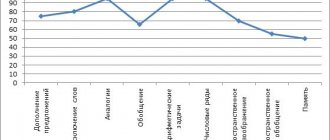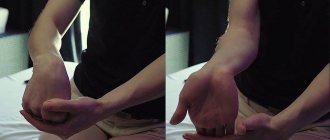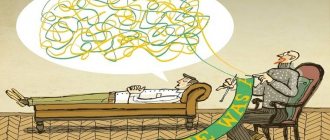A polygraph is a complex device designed to obtain information about the state of the body during testing of a person in order to find out whether the person being tested is telling the truth or lying. The lie detector is universal, applicable to any person, regardless of age and mental state. The main feature of the polygraph is to detect not the lie itself, but the reaction of the person being studied to the questions posed to him. The concept of reaction contains a large number of criteria, such as changes in respiration and blood pressure, pulse rate, and electrical resistance of the skin.
In the article you will learn how a polygraph works, get acquainted with the principle of its operation and its structure.
How does a lie detector (polygraph) work?
The one who admits to lying is always suspected more than the one who actually lies.
Lie detector (Deceiver)
- 1.Device diagram
- 2. Oscillograms
- 3. The principle of operation of the polygraph
- 4.Polygraph examination
- 5.Video: How a lie detector works
- 6.Relevance of using the polygraph
- 7. Factors affecting the test result
- 8.Results of the inspection
- 9.How the polygraph works: briefly
- 10.How to fool a lie detector
- 11. Reviews
- 12.Criticism
- CPD in the Ministry of Internal Affairs tests online - 2021 (with answers)
- Domino test in the FSB - online with answers
- How to pass a polygraph without problems: practical advice from experienced people
- How to take a polygraph test at the FSB: features of the process and important tips
- How legal is a polygraph test?
Device diagram
A polygraph is a complex composite device consisting of several elements.
The diagram and composition of lie detector devices is as follows:
- Sensors
_ Designed to monitor and obtain data on the psychophysiological state of the human body. - COMPUTER
. A computing machine, which in most cases is represented by a desktop computer. Records and processes received data from polygraph sensors. Subsequently, the computer converts the received information into an analog code and transmits it to the output device. - Output device
. An oscilloscope, printer, or monitor screen is used as such a device. These devices display the information received by the polygraph sensors on a diagram (polygram).
The period between the moments when data is received by the sensors and displayed on the diagram lasts ~600 ms (0.6 s); in fact, data on the state of the body is displayed in real mode.
Based on the results of analyzing the information on the diagram, the specialist makes a conclusion whether the answer of the person taking the polygraph test is true or false.
Oscillograms
With the help of sensors, everything is recorded and displayed on a computer oscilloscope.
Regardless of a person’s desire, the reactions of his body give out all the truthful information. In this case, the facial expression may remain unchanged, the person may behave at ease, smile, assert, and give absolutely no indication that he is lying, however, he is unable to control the physiological reactions of the body. Moreover, they cannot be dulled even by taking super-strong doses of sedatives, a state of sleep or hypnosis, as well as a complete absence of fear or excitement.
The inability to consciously manage and control the reactions occurring in the body, their close connection with current information stored in memory, makes the survey method using a lie detector scientifically sound. This method is recognized as reliable and effective in identifying information hidden by a person in many countries around the world.
How the polygraph works
The principle of operation of a lie detector is based on the detection of microstress.
During the test, many sensors are attached to the human body in places where changes in blood pressure and breathing can be easily detected. The subject is then asked specially designed questions.
When a person gives a false answer, a reflex is triggered subconsciously, as a result of which blood pressure and breathing change. The subject becomes unable to control and restrain the body’s escalating physiological reactions.
The work of the polygraph is based on identifying and recording microstress in a person. There are many sensors attached to the human body that record sudden changes in the body's response. Sensors are attached to places in the body where changes in the psychophysiological state of the body are more clearly detected.
Key indicators observed by polygraph sensors:
- arterial pressure;
- breathing rhythm;
- increased heart rate;
- sweating
When all the sensors are installed, the person takes a test consisting of many questions.
For a high-quality polygraph test with a guaranteed result, the following conditions must be met:
- No noise or sudden movements
. Third-party activity distracts the person being tested by a polygraph, which affects physiological changes in the body, and therefore the sensor readings. - Simplicity of questions
. Basically, questions are asked with the answer options “yes” or “no”. More complex questions prompt a person to think more, which also leads to changes in the body. - Lack of amnesia
. If you lose your memory of the event or subject about which the question is asked, the polygraph result is invalid. If a person was a witness or participant in a situation, but does not remember anything about it, regardless of the answer of the person being tested, the required reaction of the body will not follow.
In the event of a knowingly false answer on the part of the person being tested, an unconditioned reflex is triggered at a subconscious level, which cannot be consciously controlled or prevented before it occurs.
The resulting reflex, in turn, creates a microreaction of the body, which is reflected in changes in the psychophysiological state. Even knowing how a polygraph works, it is impossible to deceive it, since the reason for revealing the truth is not in the lie detector, but in the functioning of the human brain - the detector only records the body’s reaction.
The sensor readings are transmitted to a computer, which converts the digital data into analog code, and then sends it to the output device.
Based on the results of the polygram analysis, a polygraph examiner with knowledge of the operation of a lie detector reports the manifestation of “truth” or “lie” on the part of the person being questioned. In this case, a person’s reaction may look completely calm, without changing his facial expression or averting his eyes; the interrogated person may not change his mood and calmly assert the truth on his part. However, it is impossible to control or restrain the physiological abilities of the brain.
The brain is not able to deceive itself and, regardless of a person’s desire or external factors, reproduces various reflexes in the case of truth and deception. The impossibility of conscious control of reactions and processes within the body, as well as their close dependence on current information stored in memory, gave scientific justification and recognition to the polygraph testing method.
How to behave during an inspection
While taking the test, you need to concentrate and not be nervous. You can’t fuss, because additional questions from the polygraph examiner will bring an imbalance to the emotional background. It is necessary to listen carefully to each question and answer clearly, without doubt. If a person finds it difficult to answer, then it is necessary to tell a specialist about it. Each answer is given 10 seconds, so you don’t have to rush. You only need to answer “Yes” or “No”.
Interview with a polygraph examiner
During a polygraph examination of a subject, the device clearly records changes in all physiological parameters that occur in the human body when he answers.
Then, based on the reactions received, the specialist determines which of the questions the respondent gave a false answer to. To conduct testing, it is necessary to obtain written consent of the established form from the suspect (victim, witness). But since the data obtained are probabilistic in nature, they cannot be taken into account by the court as direct evidence of guilt or innocence.
The relevance of the use of the polygraph
The lie detector is used in many areas, which is not surprising, because a polygraph test is currently the only way to verify the truth of a person’s words.
The polygraph is used in the following cases:
- Checking the company's staff
. Before making a decision to hire a new employee, serious corporations carry out a set of measures with him, including a lie detector test. A polygraph helps to find out in advance a person’s intentions and the purpose of employment, which is objective from a security point of view. - Investigation of crimes
. A lie detector helps to establish the guilt of a suspect in a crime. We especially use it in situations where a person’s guilt in committing a crime is obvious, but for bureaucratic reasons it is impossible to bring charges against him. - Special cases
. Lie detectors have also widely proven themselves to be useful in finding out the truth in individual cases, for example, when it is necessary to check the fidelity of a spouse. Today, in many countries, private companies offer human testing services using a lie detector.
Scope of use
A polygraph is a device that is used to make personnel decisions, which is in demand in the military, scientific, and political spheres. A device that allows you to catch a person in a lie is effective as an anti-corruption measure. The tasks solved with the help of polygraph examination boil down to identifying hidden or distorted information.
Some professions that are associated with the public service (security service, prosecutor's office, police, research institutes) require state secrets, access to classified information, and require careful selection of employees. If a person wants to work in bodies such as the Ministry of Internal Affairs, the FSB, the prosecutor's office, the Ministry of Emergency Situations, he will have to undergo a polygraph test. During testing, the following data is clarified:
- Personal information, biographical facts.
- Committed illegal actions, crimes.
- Alcohol abuse, use of narcotic substances, psychotropic drugs (without a doctor's prescription).
- Hidden motivation (selfish intent) for applying for a position.
- Presence of a conflict of interest.
- Disclosure of information constituting a state secret or confidential information.
- Covert cooperation with foreign military and intelligence agencies.
- State of health (in cases where appointment to a position requires compliance with certain physical parameters and psychological characteristics).
The polygraph is also used in biological and psychological research and in medical practice. Specialized devices are used to identify information hidden by people suspected of committing crimes. There is practice of using the device by foreign industrial and trading companies, and banking institutions.
In Russia, the device is used as part of operational investigative activities. PFI is a psychophysiological study that includes several testing options (a survey by a psychologist, writing an autobiography, psychological tests) and is intended to identify a person’s competence in any professional field. As part of the PFI, a polygraph examination is carried out.
Factors affecting the test result
There are four main reasons why the results of a lie detector test are considered biased:
- Location
. The test subject's body should not be distracted by external situations and phenomena not related to the test. - Time spending
. Based on the results of many tests, over ten years of observation, polygraph examiners have determined that the most favorable period of the day for taking a polygraph test is from morning to lunch. - Number of checks per day
. It is recommended no more than three checks by one polygraph examiner. - Psychotropic effects or alcohol/drug intoxication
. It is similar to the first reason, with the difference of a stronger impact on the psyche. Even if it is possible to test a person in the above-mentioned condition, the test results left by the polygraph on the polygram will be different.The results of testing a person in a state of passion are different from the results of a sober person due to a more inhibited reaction of consciousness in the first. Such results cannot be analyzed even by experienced polygraph examiners and are considered irrelevant.
And, by the way, during the New Year holidays, the polygraph and polygraph examiners do not work the same way as everyone else.) Do not try to test someone on these days.
In some Western countries that use lie detectors in legal matters, violation of any of the above points may lead to the cancellation of the test results and invalidate them.
Restrictions on polygraph testing
First, there are limitations in the nature of the questions. It is prohibited to ask questions of the following nature:
- concerning military and state secrets of the Russian Federation,
- related to racial, religious and political beliefs,
- relating to personal life,
- humiliating the honor and dignity of a person.
Secondly, the results of a Polygraph (lie detector) test in the Russian Federation have indicative value and cannot be legal evidence of guilt.
Another limitation is related to the use of a polygraph in the workplace. In order to use a polygraph, the employer must include a clause on passing the test in the text of the employment contract, as one of the conditions for hiring. For working personnel - make an appropriate proposal (can be verbal) or include a clause on the need for periodic surveys in the employment contract with the employee, for example, during the annual recertification. The Labor Code establishes a strict list of grounds for refusal to hire, and avoiding an interview with a polygraph examiner is not one of them.
Check results
According to statistics, conclusions drawn on the basis of a polygraph are of very high reliability (80–90%).
When the tactics of using a lie detector accurately implement the principle of selective influence, all conclusions turn out to be reliable. In addition to the image or word, the actions of the investigator and the person or object during its presentation for delay can also have such an impact. All this indicates the breadth of tactical coverage of situations in which a polygraph can be used.
The polygraph works when there is a subject and sensors that are attached to it. Afterwards, a record is made, all indicators are recorded, significant points are compared with insignificant ones. Then, based on all this, appropriate conclusions are drawn.
There are some difficulties in working with a polygraph. They consist in the fact that the person being tested is placed in unusual conditions.
The whole process resembles a medical examination, which causes the subject to become agitated. A so-called situational reflex arises, which the polygraph examiner needs to remove. To do this, they try to bring the test closer to natural conditions. Sometimes, specialists working with a polygraph try to make it so that there is no need to install sensors, and the person being tested does not even imagine that he is being tested at all.
How a polygraph works: briefly
Surely everyone has heard about lie detectors used in police investigations.
But sometimes people who are applying for a new job have to undergo a similar polygraph test (for example, some government jobs where the results of a lie detector test are required from the FBI or CIA). The main purpose of a polygraph is to see whether a person is lying when answering certain questions or telling the truth. When a person takes a polygraph test, 4 to 6 sensors are attached to his body. A lie detector is a machine that records multiple (“POLY-”) sensor signals on moving paper (“-GRAPH”).
Polygraph sensors usually record:
- breathing rate;
- pulse;
- arterial pressure;
- sweating
Sometimes the polygraph also records data such as reactions and movements of the arms and legs.
When a polygraph test begins, the examiner asks three or four simple questions to establish signal standards. Then real questions are asked to test the detector. During the interrogation process, all signals coming from sensors attached to the body are recorded on moving paper.
Before the test begins and after its completion, the polygraph examiner looks at the graphs and sees the nature of changes in important indicators as a result of the questions asked. Most often, significant changes (such as increased heart rate, increased blood pressure, increased sweating) indicate that a person is lying.
When a trained professional uses a polygraph, he can detect lies with high accuracy. However, due to the fact that the expert's interpretation is largely subjective, and people react to lies differently, a polygraph test is far from the most perfect method.
The principle of operation of a lie detector
The principle of operation of the device is based on the idea that when a person answers a question with a lie, microstress arises in his body. Due to nervous tension and excitement, the following indicators may change:
- Breathing rhythm;
- Arterial pressure;
- The intensity of sweating;
- Pulse.
To detect these minor disturbances, special sensors are used that are connected to the human body. During the testing process, the polygraph examiner uses a special technique that allows the subject to identify the correct answers.
It is important that the work is carried out by specialists, because only in this case will it be possible to correctly interpret the information received and identify the fact of lies.
How to fool a lie detector
As already mentioned, the polygraph is actually impossible to deceive: it only registers changes, while the changes themselves to a false answer occur in the human body, caused by unconditioned reflexes of the central nervous system.
And yet, is it possible to hide a lie? Theoretically, yes, such a possibility exists. To conceal a lie, it is necessary to control and anticipate unconditioned reflexes even before they arise. The brain of an ordinary person is not capable of this, which was confirmed every time they tried to deceive the polygraph. The outcome of such attempts was a slight deviation in the test subject’s body parameters, but the overall picture of the results did not differ from the results of tests in which the test subject did not attempt to deceive.
Control of unconditioned reflexes is comparable to supernatural abilities. And such people really exist, but there are only a few of them in the whole world, and the chance of meeting a person with supernatural abilities is equal to the chance of an ordinary person becoming the mayor of a large city. These cases are unique and, if individual people have hidden abilities, their brain works differently, which is reflected in the test readings. In such cases, a lie detector test is considered more irrelevant than reliable.
The principle of operation of a lie detector.
For many centuries, people have tried in various ways to identify the truth and find out when a person is lying. In ancient China, the suspect filled his mouth with rice grains, which were examined after the accusation was announced: if the suspect is worried, his throat becomes dry, which means the grains will be dry and his guilt is undeniable. Today, to identify lies or find the truth, they use other, more advanced devices - lie detectors. From this material you will learn how the polygraph works, what it reacts to. What affects the accuracy of the test. Is it possible to deceive him?
Reviews
The lie detection procedure is first of all a METHOD, and then the hardware... Lie detection professionals know this. But only PROFESSIONALS know THIS... The technique consists first of explaining a set of questions that will be tested, and not a single question. Moreover, the emphasis in these questions is on supposed details, and not in general terms, as non-professionals believe... And when the person being tested is already stimulated to receive these questions, he is asked to answer these DETAILED questions unambiguously truthfully or falsely... This preliminary work is the main work of the polygraph examiner pro. Then mother NATURE and genetics come into play when the truthfulness of answers to these questions begins to be verified using a polygraph. And if there is significance in hiding the truth in a specific issue on the topic being tested, then the genetics of ANY adequate and stimulated person will NOT go ANYWHERE and will DEFINITELY WORK... Why? Because he is ALIVE and adequate and understands what will follow the revelation of the TRUTH. Moreover, psychophysiological reactions MUST appear in a logical sequence of questions as each question is asked separately, then in an average value and in several comparative degrees... So, not everything is as simple as you think... Only an expert in lie detection can make a mistake in the methodology and testing , not a pro... It’s like using a doctor’s thermometer... If you don’t have the symptoms of the disease you described, then there’s no point in asking you about your body temperature. And even if you try to CONVINCE (deceive) the doctor that you now have a temperature, he will OF COURSE believe not your words, but the thermometer...? Valery Evgenievich Volkov, experienced polygraph examiner










